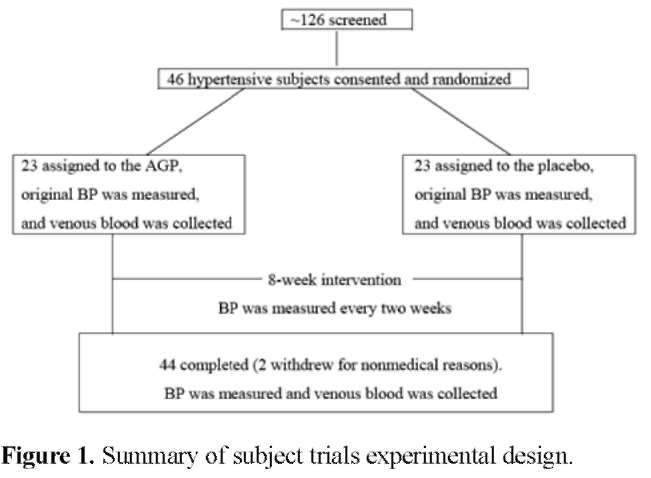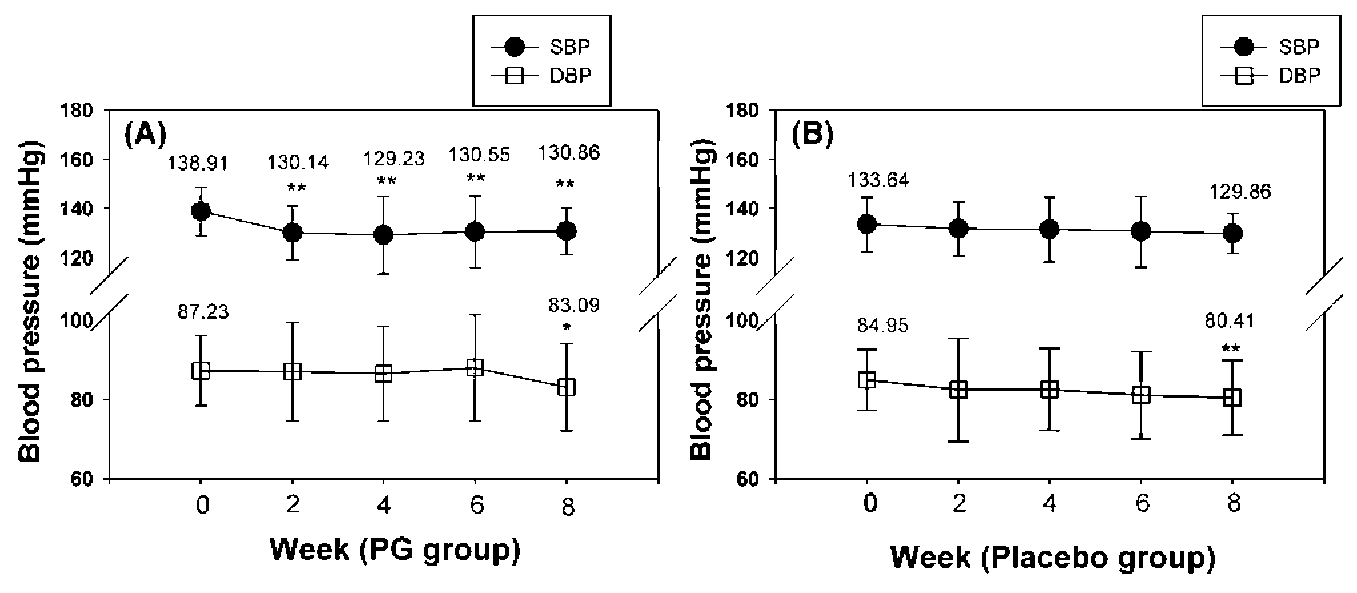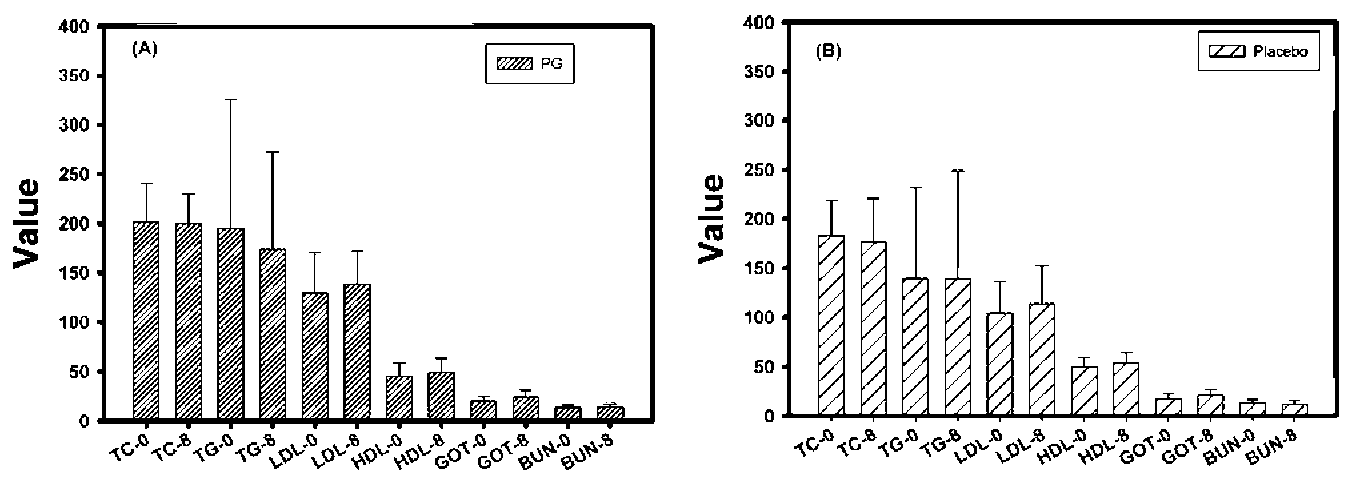278
Botanical Studies, Vol. 52, 2011
study, the goals were first, to evaluate the antihypertensive effects of processed garlic powder (PG) on SHRs, and second,to conduct a feeding trial in hypertensive subjects. In SHR, PG significantly lowered SBP and DBP after 8 weeks (p<0.05). In human subjects, taking two daily 500 mg capsules of PG for 8 weeks also lowered BP.

MATERIALS AND METHODS
Materials
PG powders, PG capsules and the placebo were provided by AGV Products Co. (Chia-Yi, Taiwan) for the animal and clinical trials. PG was manufactured as follows: raw garlic was washed then put in a reactor for two weeks. After completion of the enzymatic reaction process, the processed garlic was de-hulled, lyophilized and then powdered. The active components of S-allyl-L-cysteine were determined to be 75.3 mg/100 g in PG, and total phenolics were 775 mg/100 g. Other chemicals were from Sigma Chemical Co. (St. Louis, MO, USA).
and lactating women, people who had received trace element supplements in the previous three months, people receiving gastric or diuretic treatments, patients with acute renal failure, or people with recent history of surgery or acute infections. All subjects were informed of the purposes of the study, were free to ask questions throughout the study, and signed an informed consent form witnessed by one of the investigators. This clinical trial was designed as a randomized, placebo-controlled parallel feeding trial (Figure 1). Forty-six subjects (35 males and 11 females) were randomly assigned to either control or treatment groups. GP or placebo capsules kept in a dark bottle were then given to subjects. They were instructed to take two 500 mg capsules of PG or placebo daily, together with 200 ml of water, 30 min after breakfast for 8 weeks. Eating habits were not restricted during the treatment. However, to avoid possible interference with the effects of PG, the consumption of vitamin supplements and functional foods was prohibited during the trial. Each subject's BP was measured at the beginning of the trial, then once every two weeks during the trial. Their BP was measured using a digital BP analyzer (ES-P110, Terumo Corp., Tokyo, Japan) and recorded as the average of two measurements. Measurements were always made at the same place and time after 15 min of rest. Venous blood was also collected from each subject before and after the trial. Blood samples were assayed for serum lipid profiles and for other biochemical cardiovascular risk markers (e.g., total cholesterol (TC), triglyceride (TG), glutamate oxaloacetate transaminase (GOT), low density lipoproteins (LDL), high density lipoproteins (HDL), and blood urea nitrogen (BUN)) in the Department of Laboratory Medicine, Taipei Medical University Hospital.
Effects of antihypertensive activity of PG on SHR
Before the rat feeding trial, effects of PG on the SBP and DBP of SHR were determined using the method of Liu et al. (2009a, b). All animal experimental procedures were approved by the Institutional Animal Care and Use Committee and followed published guidelines (National Science Council, 1994). The male SHRs (5 weeks of age, National Laboratory Animal Center, Taipei) were housed individually in steel cages kept at 24°C with a 12-h light-dark cycle and had free access to a standard mouse/rat chow (Prolab® RMH2500, 5P14 Diet, PMI Nutrition International, Brentwood, MO) and water. After being housed up to 14 weeks, they were randomly divided into three groups (eight rats per group), one of these the control group. All were given 30 mg of PG/Kg and 50 mg of PG/ Kg (suspended in 0.5 ml water) once a day for 8 weeks, and the control group was then orally administered 0.5 ml water. SHR tail blood pressure was measured once every 2 weeks before each oral administration. Before each blood pressure measurement, SHRs were warmed for 10 min in a 39°C thermostated box. SHR tail blood pressure was measured every two weeks. An indirect blood pressure meter (BP-98A, Softron Co. Ltd. Tokyo, Japan) was used to measure SBP and DBP four times in each determination for each treatment.
Subjects and clinical trials
The Institutional Review Board of Taipei Medical University approved the clinical trial design (approval number P970401). Subjects were males and females aged 20 to 60 years with pre-hypertension (SBP, 130 to140 mmHg and DBP, 85 to 90 mmHg) or hypertension (SBP, 140 mmHg or higher and DBP, 90 mmHg or higher) that was con-firmed by an internal medicine physician at Taipei Medical University Hospital. Exclusion criteria included pregnant
Statistical analysis
Each data was expressed as mean 士 S.D. Effects of PG on SHR BP were assessed by a one-way ANOVA followed by a post hoc Tukey's test to compare SBP or DBP between PG (30 and 50 mg/Kg) and the control group at the fixed week, and values at the same time point not sharing an alphabetic letter are significantly different (P<0.05). Effects of the PG on BP of subjects or serum lipid profiles


